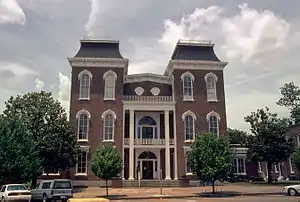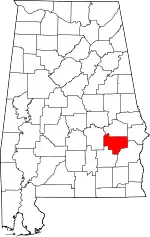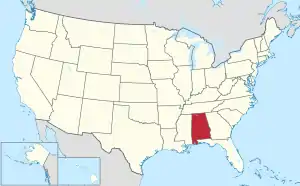Bullock County, Alabama
Bullock County is a county of the U.S. state of Alabama. As of the 2010 United States Census, the population was 10,914.[1] Union Springs was chosen as the county seat in 1867, and presently is the county's only incorporated city.[2] The county was named for Confederate Army Colonel Edward C. Bullock who was a state senator and outspoken secessionist who died during the American Civil War.[3]
Bullock County | |
|---|---|
 Bullock County courthouse in Union Springs | |
 Location within the U.S. state of Alabama | |
 Alabama's location within the U.S. | |
| Coordinates: 32°05′52″N 85°43′02″W | |
| Country | |
| State | |
| Founded | 5 December 1866 (created) |
| Named for | Edward Bullock |
| Seat | Union Springs |
| Largest city | Union Springs |
| Area | |
| • Total | 625 sq mi (1,620 km2) |
| • Land | 623 sq mi (1,610 km2) |
| • Water | 2.3 sq mi (6 km2) 0.4%% |
| Population (2010) | |
| • Total | 10,914 |
| • Estimate (2019) | 10,101 |
| • Density | 16.2/sq mi (6.3/km2) |
| Time zone | UTC−6 (Central) |
| • Summer (DST) | UTC−5 (CDT) |
| Congressional district | 2nd |
| Website | bullockcountyalrev |
| |
A National Center for Education Statistics report released in January 2009 showed that Bullock County had the highest illiteracy rate in Alabama at 34 percent.[4]
History
Bullock County was established by act of the state legislature dated 5 December 1866, with areas partitioned from Macon, Pike, Montgomery, and Barbour counties.[5] The boundaries were changed in February 1867.
Prior to the arrival of white settlers, the future Bullock County was inhabited by Creek Indians. The Treaty of Fort Jackson (1814) ceded much of Alabama and Georgia to the US government, and the Creeks were removed completely after 1830. From 1818 through the 1830s, white settlers poured into the area, turning the rich soil into cotton-producing plantations and the area into one of the state's richest.
Bullock County was devastated by the Civil War. Its once-enslaved population (about seventy percent of the total population) had sustained its output, but their emancipation caused a sharp decline in the economy. In the aftermath, Bullock County elected two former slaves to the state legislature, but with end of Reconstruction, the black population were severely restricted and kept down.[5]
By 1877 the boll weevil had migrated into Bullock County cotton fields from Mexico, and the area's economy was further depressed. A significant portion of the once-cotton-producing area was converted to a site of the Amateur Field Trial competition for bird dogs and a game preserve.[5]
Geography
Prior to white settlement, the future Bullock County terrain was completely wooded. It still bears a significant coverage of trees,[6] with the remainder having been cleared for agricultural or urban usage.[7] A range of hills, called Chunnenugga Ridge, bisects the county running east to west. It forms the watershed for the Tallapoosa River on the north, and streams on the south that flow to the Gulf of Mexico, including the Conecuh River, which flows through the extreme west end of Florida to reach the Gulf. The highest point on this ridge (approximately 670 feet/201 meters ASL) lies about 3 miles (4.8 km) west of Sehoy Lake.[8]
According to the Census Bureau, the county has a total area of 625 square miles (1,620 km2), of which 623 square miles (1,610 km2) is land and 2.3 square miles (6.0 km2) (0.4%) is water.[9]
Adjacent counties
- Macon County - north
- Russell County - northeast
- Barbour County - southeast
- Pike County - southwest
- Montgomery County - west
Major highways
 U.S. Highway 29
U.S. Highway 29 U.S. Highway 82
U.S. Highway 82 State Route 51
State Route 51 State Route 110
State Route 110 State Route 197
State Route 197 State Route 239
State Route 239
Airport
- Franklin Field - county-owned public-use airport, 5.2 miles/8.4 km WNW from Union Springs.[10][11]
Communities
City
- Union Springs (county seat)
Town
Census-designated place
Unincorporated communities
Ghost town
Demographics
| Historical population | |||
|---|---|---|---|
| Census | Pop. | %± | |
| 1870 | 24,474 | — | |
| 1880 | 29,066 | 18.8% | |
| 1890 | 27,063 | −6.9% | |
| 1900 | 31,944 | 18.0% | |
| 1910 | 30,196 | −5.5% | |
| 1920 | 25,333 | −16.1% | |
| 1930 | 20,016 | −21.0% | |
| 1940 | 19,810 | −1.0% | |
| 1950 | 16,054 | −19.0% | |
| 1960 | 13,462 | −16.1% | |
| 1970 | 11,824 | −12.2% | |
| 1980 | 10,596 | −10.4% | |
| 1990 | 11,042 | 4.2% | |
| 2000 | 11,714 | 6.1% | |
| 2010 | 10,914 | −6.8% | |
| 2019 (est.) | 10,101 | [12] | −7.4% |
| US Decennial Census[13] 1790–1960[14] 1900–1990[15] 1990–2000[16] 2010–2018[1] | |||
2010 census
As of the 2010 United States Census, there were 10,914 people in the county. 70.2% were Black or African American, 23.0% White, 0.4% Pacific Islander, 0.2% Native American, 0.2% Asian, 5.2% of some other race and 0.8% of two or more races. 7.1% were Hispanic or Latino (of any race).[17]
2000 census
As of the 2000 United States Census,[18] there were 11,714 people, 3,986 households, and 2,730 families in the county. The population density was 19 people per square mile (7/km2). There were 4,727 housing units at an average density of 8 per square mile (3/km2). The racial makeup of the county was 73.11% Black or African American, 25.25% White, 0.38% Native American, 0.18% Asian, 0.02% Pacific Islander, 0.37% from other races, and 0.70% from two or more races. 2.75% of the population were Hispanic or Latino of any race.
There were 3,986 households, out of which 33.50% had children under the age of 18 living with them, 35.50% were married couples living together, 28.20% had a female householder with no husband present, and 31.50% were non-families. 28.90% of all households were made up of individuals, and 12.30% had someone living alone who was 65 years of age or older. The average household size was 2.56 and the average family size was 3.13.
The county population contained 26.10% under the age of 18, 10.30% from 18 to 24, 29.30% from 25 to 44, 21.20% from 45 to 64, and 13.20% who were 65 years of age or older. The median age was 35 years. For every 100 females there were 110.20 males. For every 100 females age 18 and over, there were 113.40 males.
The median income for a household in the county was $20,605, and the median income for a family was $23,990. Males had a median income of $22,560 versus $19,069 for females. The per capita income for the county was $10,163. About 29.80% of families and 33.50% of the population were below the poverty line, including 44.70% of those under age 18 and 29.10% of those age 65 or over.
Government and infrastructure
Bullock County is powerfully Democratic. The only Republican to carry the county since 1900 has been Barry Goldwater in 1964 – when essentially none of the county's black majority had voted for over seven decades and opposition by the voting white minority to Civil Rights meant that national Democrat Lyndon Johnson was not allowed on the ballot. Even after the Voting Rights Act of 1965, black registration was so slow that segregationist Governor George Wallace carried the county by five percentage points in 1968, but since then the Democratic presidential candidate has carried Bullock in every election. It was one of only six Wallace counties[lower-alpha 1] to vote for George McGovern against Richard Nixon’s 3,000-plus-county landslide of 1972.
| Year | GOP | DEM | Others |
|---|---|---|---|
| 2020 | 24.8% 1,146 | 74.7% 3,446 | 0.5% 21 |
| 2016 | 24.2% 1,140 | 75.0% 3,530 | 0.9% 40 |
| 2012 | 23.5% 1,251 | 76.3% 4,061 | 0.2% 10 |
| 2008 | 25.7% 1,391 | 74.1% 4,011 | 0.2% 13 |
| 2004 | 31.7% 1,494 | 68.1% 3,210 | 0.3% 13 |
| 2000 | 29.2% 1,433 | 69.2% 3,395 | 1.6% 76 |
| 1996 | 26.3% 1,154 | 70.2% 3,078 | 3.5% 152 |
| 1992 | 26.0% 1,253 | 67.7% 3,259 | 6.3% 304 |
| 1988 | 31.0% 1,421 | 68.1% 3,122 | 0.9% 41 |
| 1984 | 32.0% 1,697 | 66.8% 3,537 | 1.2% 65 |
| 1980 | 25.7% 1,446 | 70.3% 3,960 | 4.1% 231 |
| 1976 | 29.1% 1,482 | 69.4% 3,536 | 1.5% 74 |
| 1972 | 47.4% 2,178 | 50.6% 2,321 | 2.0% 92 |
| 1968 | 4.4% 190 | 45.2% 1,964 | 50.5% 2,193 |
| 1964 | 57.6% 1,516 | 42.4% 1,114 | |
| 1960 | 35.1% 412 | 64.5% 757 | 0.4% 5 |
| 1956 | 24.3% 304 | 64.9% 812 | 10.9% 136 |
| 1952 | 32.5% 442 | 67.5% 918 | 0.0% 0 |
| 1948 | 1.2% 10 | 98.8% 799 | |
| 1944 | 2.2% 24 | 97.8% 1,056 | 0.0% 0 |
| 1940 | 1.4% 18 | 98.6% 1,301 | 0.0% 0 |
| 1936 | 0.4% 5 | 99.5% 1,188 | 0.1% 1 |
| 1932 | 1.2% 12 | 98.7% 1,004 | 0.1% 1 |
| 1928 | 26.3% 249 | 73.7% 699 | 0.0% 0 |
| 1924 | 1.0% 8 | 98.8% 763 | 0.1% 1 |
| 1920 | 0.2% 2 | 99.7% 877 | 0.1% 1 |
| 1916 | 0.5% 4 | 99.2% 743 | 0.3% 2 |
| 1912 | 0.5% 4 | 99.2% 736 | 0.3% 2 |
| 1908 | 1.3% 10 | 98.7% 782 | 0.0% 0 |
| 1904 | 0.0% 0 | 99.7% 726 | 0.3% 2 |
Alabama Department of Corrections operates the Bullock Correctional Facility in an unincorporated area in the county.[20][21]
Climate
| ||||||||||||||||||||||||||||||||||||||||||||||||||||||||||||||||||||||||||||||||||||||||||||||||||||||||||||||||||||||||||||
See also
References
- "State & County QuickFacts". US Census Bureau. Archived from the original on May 17, 2014. Retrieved May 15, 2014.
- "Find a County". National Association of Counties. Archived from the original on May 31, 2011. Retrieved June 7, 2011.
- "Bullock County, Alabama History, ADAH". Alabama Department of Archives and History. Retrieved June 12, 2019.
- The Associated Press (January 8, 2009). "Study finds Alabama literacy rate improved, Shelby County has state's lowest illiteracy". AL.com.
- "Bullock County". Auburn University Outreach/Encyclopedia of Alabama. 28 June 2007. Retrieved 13 September 2020.
- "The forests support an abundance of such growth as pine, red, post, and white oak, together with elm, poplar, gum, ash. hickory, walnut, chestnut, magnolia, cottonwood, maple, and dogwood." (History of Bullock County, Alabama/Genealogy Trails - accessed 13 September 2020)
- Bullock County AL (Google Maps, accessed 13 September 2020)
- Bullock County High Point, Alabama (PeakBagger.com, accessed 13 September 2020)
- "2010 Census Gazetteer Files". US Census Bureau. August 22, 2012. Retrieved August 22, 2015.
- FAA Airport Form 5010 for 07A PDF. Federal Aviation Administration. Effective 3 June 2010.
- Franklin Field (Google Maps, accessed 13 September 2020)
- "Population and Housing Unit Estimates". Retrieved May 17, 2019.
- "US Decennial Census". US Census Bureau. Retrieved August 22, 2015.
- "Historical Census Browser". University of Virginia Library. Retrieved August 22, 2015.
- Forstall, Richard L., ed. (March 24, 1995). "Population of Counties by Decennial Census: 1900 to 1990". US Census Bureau. Retrieved August 22, 2015.
- "Census 2000 PHC-T-4. Ranking Tables for Counties: 1990 and 2000" (PDF). US Census Bureau. April 2, 2001. Retrieved August 22, 2015.
- 2010 census report for Bullock County, Alabama
- "US Census website". US Census Bureau. Retrieved 14 May 2011.
- "Atlas of US Presidential Elections". Retrieved November 15, 2016.
- Bullock Correctional Facility Archived 2011-10-08 at the Wayback Machine. Alabama Department of Corrections. Retrieved on July 1, 2011.
- Union Springs city, Alabama. US Census Bureau. Retrieved on July 4, 2011.
- "NASA Earth Observations Data Set Index". NASA. Retrieved 30 January 2016.
Notes
- The others were the fellow Alabama counties of Lowndes and Wilcox with similarly delayed black registration after 1965, and the white majority, historically secessionist Middle Tennessee trio of Houston County, Perry County and Stewart County.
External links
- Barbour / Bullock County Drug Task Force Webpage
- Alabama State Archives
- Markers from Alabama State Archives
- Owen, Thomas McAdory. History of Alabama and Dictionary of Alabama Biography. Chicago: S.J. Clarke Publishing Co., 1921.
